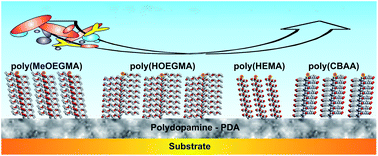Biomimetic non-fouling surfaces: extending the concepts†
Abstract
In this study, we propose a substrate-independent biomimetic modification route for the creation of antifouling

Maintenance work is planned for Wednesday 1st May 2024 from 9:00am to 11:00am (BST).
During this time, the performance of our website may be affected - searches may run slowly and some pages may be temporarily unavailable. If this happens, please try refreshing your web browser or try waiting two to three minutes before trying again.
We apologise for any inconvenience this might cause and thank you for your patience.
* Corresponding authors
a
Institute of Macromolecular Chemistry, Academy of Sciences of the Czech Republic, v.v.i., Heyrovsky sq. 2, 162 06 Prague, Czech Republic
E-mail:
rodriguez@imc.cas.cz
Fax: +420 296 809 410
Tel: +420 296 809 111
b
College of Engineering, Universidad de la Republica, Julio Herrera y Reissig 565, Montevideo, Uruguay
Fax: +598 2711 5446
Tel: +598 2711 0698
In this study, we propose a substrate-independent biomimetic modification route for the creation of antifouling

 Please wait while we load your content...
Something went wrong. Try again?
Please wait while we load your content...
Something went wrong. Try again?
O. Pop-Georgievski, C. Rodriguez-Emmenegger, A. D. L. S. Pereira, V. Proks, E. Brynda and F. Rypáček, J. Mater. Chem. B, 2013, 1, 2859 DOI: 10.1039/C3TB20346H
To request permission to reproduce material from this article, please go to the Copyright Clearance Center request page.
If you are an author contributing to an RSC publication, you do not need to request permission provided correct acknowledgement is given.
If you are the author of this article, you do not need to request permission to reproduce figures and diagrams provided correct acknowledgement is given. If you want to reproduce the whole article in a third-party publication (excluding your thesis/dissertation for which permission is not required) please go to the Copyright Clearance Center request page.
Read more about how to correctly acknowledge RSC content.
 Fetching data from CrossRef.
Fetching data from CrossRef.
This may take some time to load.
Loading related content
